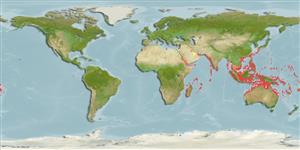Common names from other countries
Environment: milieu / climate zone / depth range / distribution range
Ökologie
seewasser riff-verbunden; tiefenbereich 10 - 45 m (Ref. 90102), usually 20 - 42 m (Ref. 9710). Tropical; 23°C - 28°C (Ref. 27115)
Indo-West Pacific: Red Sea south to Natal, South Africa (Ref. 4392) and east to Bali, Indonesia.
Size / Gewicht / Alter
Maturity: Lm ? range ? - ? cm
Max length : 13.0 cm TL Männchen/unbestimmt; (Ref. 11441)
Rückenflossenstacheln (insgesamt) : 9; Rückenflossenweichstrahlen (insgesamt) : 12; Afterflossenstacheln: 3; Afterflossenweichstrahlen: 12. Body orange-brown, with pale longitudinal blue-green lines following scale rows; head with irregular light blue-green lines; opercular flap with a black spot; caudal fin white with a broad black bar on posterior part of fin (Ref. 4392). Red Sea form is slightly different. Females are distinguished by the white versus yellow band on the base of the tail and males by the lined versus spotted pattern on the body (Ref. 48636).
Adults inhabit lagoon and seaward reefs, usually deeper than 20 m to at least 42 m (Ref. 9710). Juveniles are solitary and adults form small groups, each with several females and a dominant male (Ref. 48636). Oviparous, distinct pairing during breeding (Ref. 205). Minimum depth reported from Ref. 27115.
Life cycle and mating behavior
Maturities | Fortpflanzung | Spawnings | Egg(s) | Fecundities | Larven
Oviparous, distinct pairing during breeding (Ref. 205).
Randall, J.E., 1986. Labridae. p. 683-706. In M.M. Smith and P.C. Heemstra (eds.) Smiths' sea fishes. Springer-Verlag, Berlin. (Ref. 4392)
IUCN Rote Liste Status (Ref. 130435)
CITES (Ref. 128078)
Not Evaluated
Bedrohung für Menschen
Harmless
Nutzung durch Menschen
Fischereien: kommerziell; Aquarium: Kommerziell
Tools
Zusatzinformationen
Download XML
Internet Quellen
Estimates based on models
Preferred temperature (Ref.
115969): 24.5 - 29, mean 28 (based on 1028 cells).
Phylogenetic diversity index (Ref.
82804): PD
50 = 0.5002 [Uniqueness, from 0.5 = low to 2.0 = high].
Bayesian length-weight: a=0.00977 (0.00470 - 0.02030), b=3.07 (2.89 - 3.25), in cm Total Length, based on LWR estimates for this (Sub)family-body shape (Ref.
93245).
Trophic level (Ref.
69278): 3.4 ±0.4 se; based on size and trophs of closest relatives
Widerstandsfähigkeit (Ref.
120179): hoch, Verdopplung der Population dauert weniger als 15 Monate. (Preliminary K or Fecundity.).
Fishing Vulnerability (Ref.
59153): Low vulnerability (10 of 100).
